Lao cuisine reflects the ethnic diversity of the country and its surrounding neighbors. Laos has strong regional variations even among common dishes, with sticky rice being the staple of most meals.
A common Lao meal would consist of a richly spiced minced fish or chicken salad or larb, served with sticky rice; a jaew or paste made of chili peppers for dipping; tam mak hung – a fiery and sour fresh green papaya salad, a broth based soup like kaeng no mai (bamboo soup); fresh herbs and vegetables served raw; tropical fruit as a dessert; and is served with the local beer or lao-lao rice liquor.
Lao cuisine is similar to Thai, but more bitter, sour and spicy. Wild game and insects known commonly as “jungle food” are also enjoyed.
Vietnamese dishes like pho and spring rolls are extremely popular throughout the country. Ethnic Yunnanese Chinese food is common in Vientiane, and is reflected in the fried dough dishes which are commonly sold as street snacks.
The years of French colonialism have also given Laos a number of food items including the baguette, omelets, pâté and croissants – and coffee.
Laos food is vibrant, colorful, packed with herbs and chilies, and the combinations of ingredients are guaranteed to thrill your taste-buds.
Although the food of Laos, or Laotian food, is making waves across the world – it’s rightfully gaining popularity – it still has so much more potential.
From Luang Prabang to Vientiane, you will not believe how complex, yet refreshing at the same time, the flavors of Laos cooking can be.
In this blog post, I’m going to share with you 12 authentic Laos foods that you don’t want to miss trying.
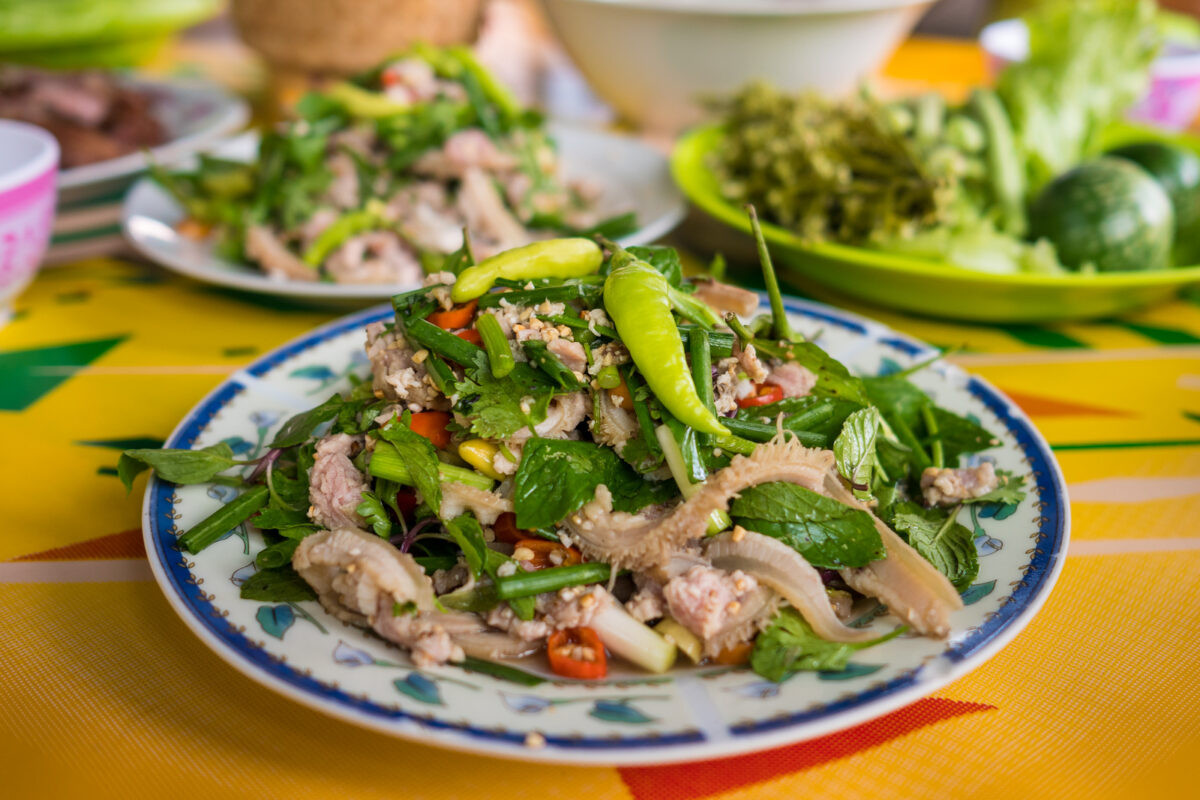
- Laap
Translated on most menus as simply a ‘meat salad,’ and also spelled in English commonly as larb or laab (laab or laap would be the most phonetically accurate), laap is one of the ultimate staple Laos foods, a heavyweight.
The word Laap actually refers to any meat prepared immediately after butchering. Always fresh, often eaten raw, this dish is a mainstay in the Laos local diet.
You can choose from any meat that the restaurant has available, but often a certain individual restaurant in Laos may specialize in pork laap, or fish laap.
The chef will often mince, then quickly fry (or keep it raw if you order the raw version) the meat while adding fish sauce, a garden full of fresh herbs (including Laos mint, cilantro, and green onions), lime juice, and toasted sticky rice powder. The rice powder is an ingredient that gives Laap its signature flavor.
All ingredients are mixed until everything is perfectly even. Local versions of Laos laap can also include bile, yes the digestive fluid, adding a unique bitterness to your plate of laap.
Very different from Laap in North-East Thailand
As opposed to the laap you’ll find in Thailand (or Isaan more specifically), Laos laap is usually heavier on the herbs.
There’s also koi, a Laos mixed salad very similar to laap, but often made with slightly blanched meat or fish.
Where to find it: Laap is widely available, and there are many different kinds, but I would recommend Pa Kam Tan restaurant in the capital city of Vientiene, or Xiengtong Restaurant in Luang Prabang, for two dishes of Laap that were out of this world.
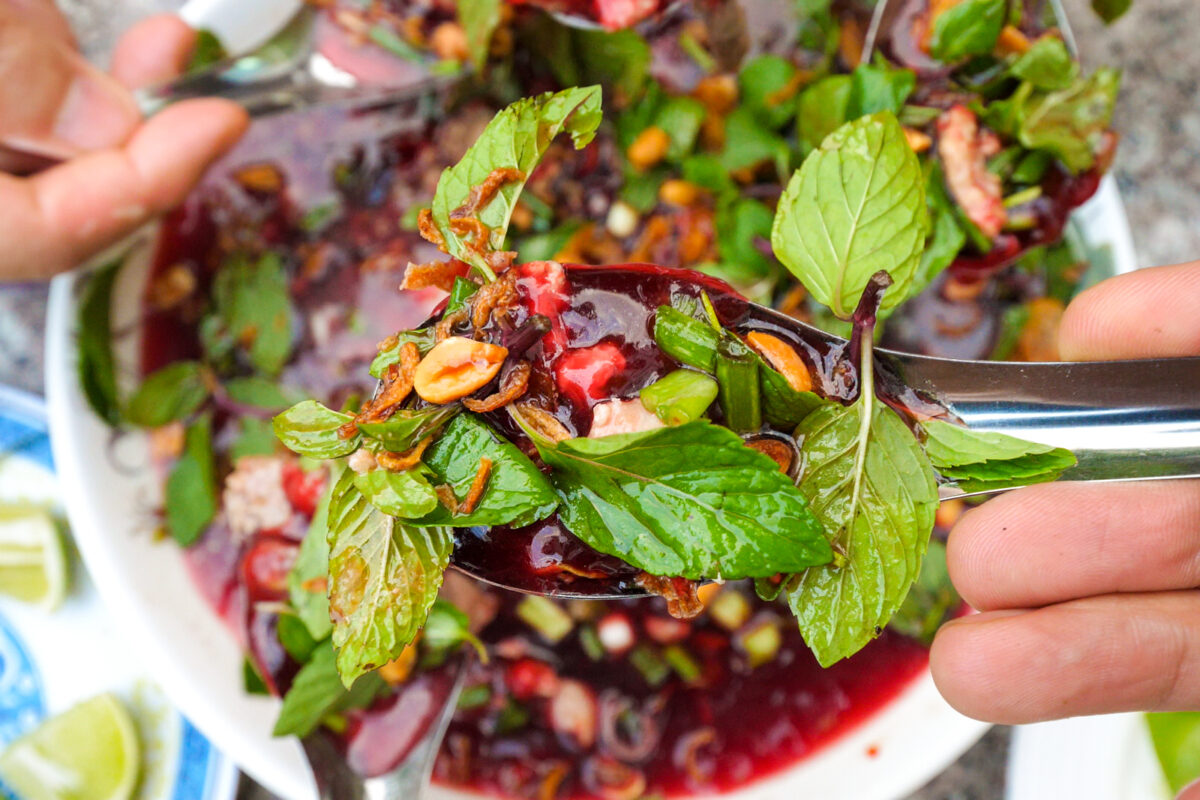
2. Paeng Pet
Stunning. This Laos food is so good that I wrote a whole article about it.
Eating raw duck blood, or even pig or goat blood, is very common in Laos.
Fresh blood is a given, and in this duck version, the blood is mixed with some cooked minced duck and organs, and again, heaps of Laos herbs like mint, green onions, and cilantro. They also often add some crispy shallots and peanuts.
Jam-packed full of herbs, yet not even close to being a vegetable dish, this combination of minty-ness, lime juice, and fire-hot from raw local chilies will set you on fire. The one-two combo of rich, oily goodness from the fried duck meat as well as its gooey and creamy blood will have you coming back for breakfast the next day.
Spooning up the duck blood, squeezing out the lime juice, chasing each bite with a shrimp paste-covered green chili pepper – this dish is just a joy to eat.
Laos’ friend’s top picks
Laos friends were raving about this dish, saying that we absolutely couldn’t miss having it, and you need to be on the lookout for Paeng Pet as well.
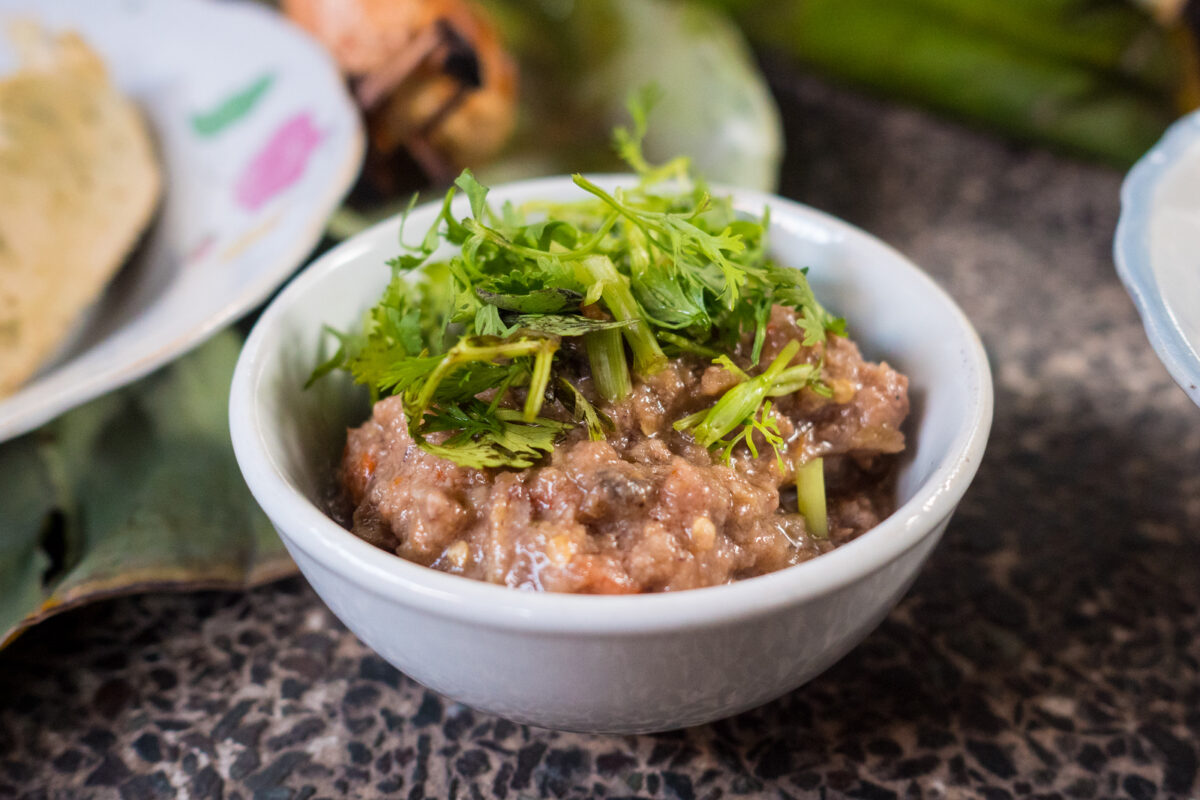
3. Jaew
Jaew can refer to any type of dipping sauce, of which Laos has a never ending abundance.
These dishes always contain chili peppers, and usually some type of grilled vegetable, giving them a distinct smoky flavor, and sometimes fermented fish. Enjoyed with sticky rice or vegetables, this is one food dear to the heart of Laos cuisine.
Made with a mortar and pestle, it’s the pounding action smashing ingredients together that makes the taste so delightfully strong. Full of Laos’ dearly-loved ingredient, the clay-pot fermented fish known as Pa Daek, is umami in the extreme.
First the garlic and raw chilis, then fish sauce and some squeezes from a lime or two, this basis can then be made into any one of a dozen recipes by adding a final vegetable and/or meat ingredient.
Some of the more common types would be Jaew Ma-Keua, made with roasted eggplant, or Jaew Moo, pork meat and pork cracklings pounded together, strikingly similar to the Chicharron Tacos in Mexico City.
Buffalo Jerky is the Secret Ingredient
Jaew bong is another local Laos favorite, a chili dip made with dried chilies, garlic, galangal, shallots, and a little dried buffalo for taste.
Where to go: This dish would usually be available at fresh markets, food markets, as it is mainly a smaller home-cooked dish. We found it at a road-side stall on the way to Phou Si Market.
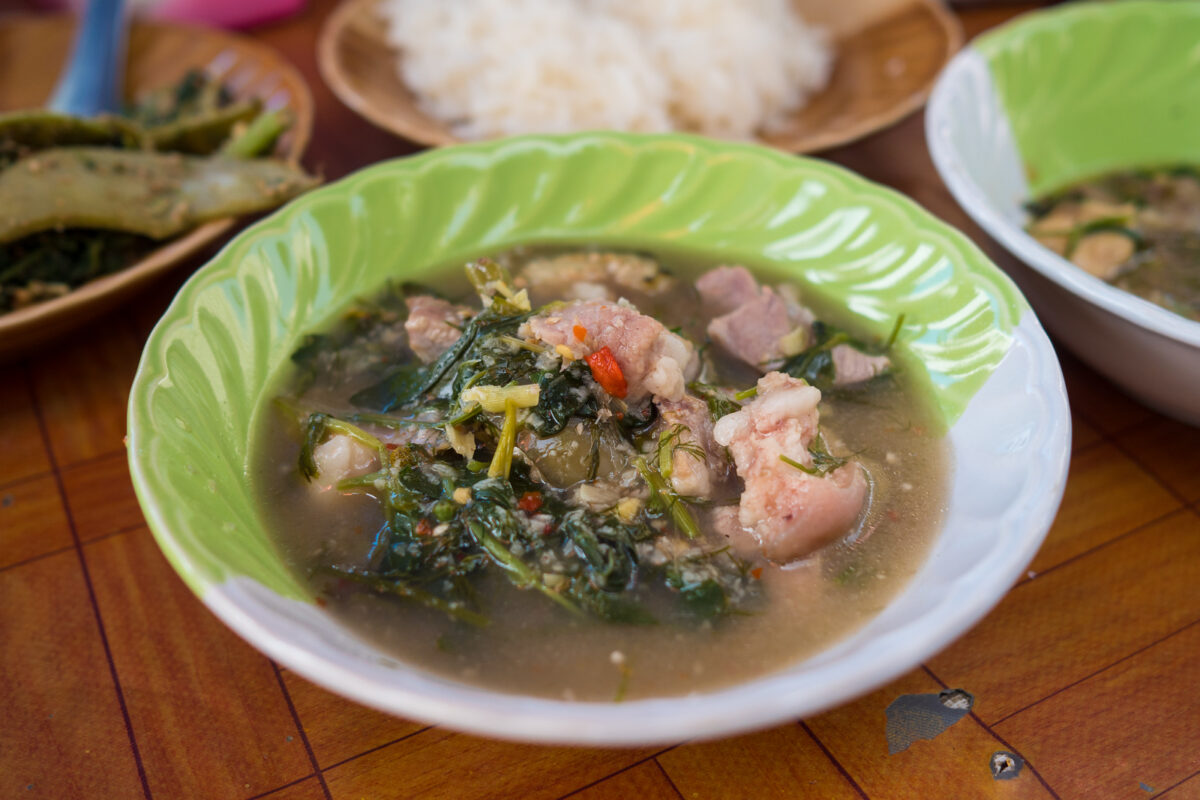
4. Or Lam
Or Lam (but better pronounced as aw lahm) is always prepared using animal fat (usually pork) instead of vegetable. Traditionally including tough yet flavorful buffalo skin, and Mai Sakaan, a magic ingredient that can only be described in English as ‘spicy chili wood.’
An extremely earthy flavor combination, it usually contains some herbs like dill or holy basil and sometimes a wild ingredient like again, mai sakaan. The broth is thick and usually kind of sticky – you can almost feel the potent nutrients among all that hearty flavor.
The special wood ingredient is very fibrous, meant to be chewed but then spit out, and it makes for a tasty and fun bite, that tingles the tongue slightly similar to Sichuan pepper. It is full of the oils and juices produced during the long stewing times of different pork parts. Or lam is an amazing Lao dish.
Perfectly Paired with Sticky Rice
Sticky rice is also a must, and this was one of the most commonly ordered dishes we saw on local tables when visiting Luang Prabang.
Where to go: Find this at any higher-end Laos restaurant, we had a great dish of it at Phamsai Houngchalern Restaurant in Luang Prabang, Laos.
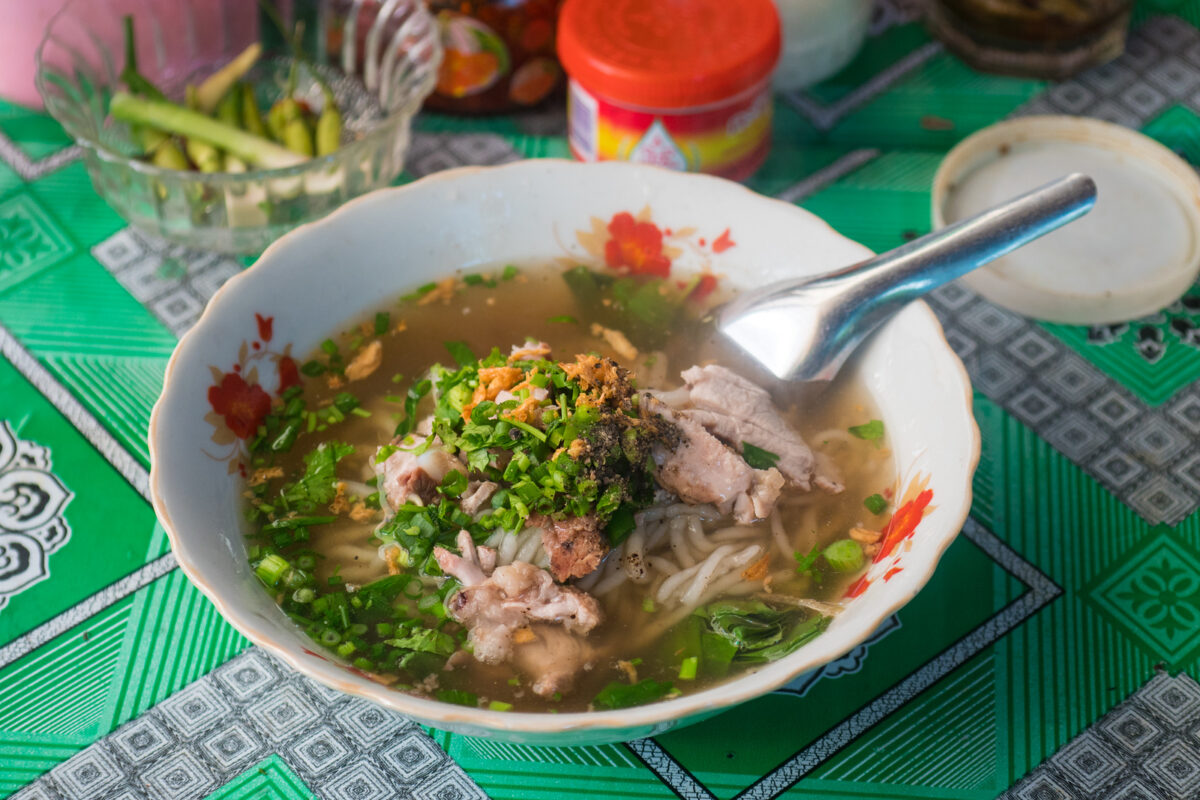
5. Khao Piak Sen
A great first meal of any full-day Laos food tour, this simple and satisfying bowl of rice noodles can be found on nearly every street corner in Laos.
Common throughout both Laos and neighboring Vietnam, there’s a reason why this dish is so iconic among travelers in the region.
Hours in the making, it begins with a massively deep flavorful meat-stock. The chef is usually up long before dawn, creating a gigantic drum full of soup and wheeling it to a restaurant’s front door. Be on the lookout for this stainless steel container, and a line of excited people beside.
Khao Piak Sen is unique among rice noodle dishes in that they use thick, hand rolled noodles. They blanch the noodles in the soup stock without removing the starch from the noodles, giving the soup an almost gravy like thickness – rather than a typical watery soup.
At the table setting you will usually find a small dish of fresh herbs, hot red peppers fried in oil (insanely good), shrimp paste, and often some dried crushed peanuts as well.
One of Laos’ Oldest Dishes
The history of this dish goes back thousands of years, the better known version made with rice instead of noodles. (I had a great dish of it myself, called Khao Piak Kao, on the way to our Khmu Village Homestay). If you find it, don’t forget to ask the chef for a few pieces of lime to take your rice soup to the next level.
Where to find it: There are a few stalls in the morning market in Luang Prabang
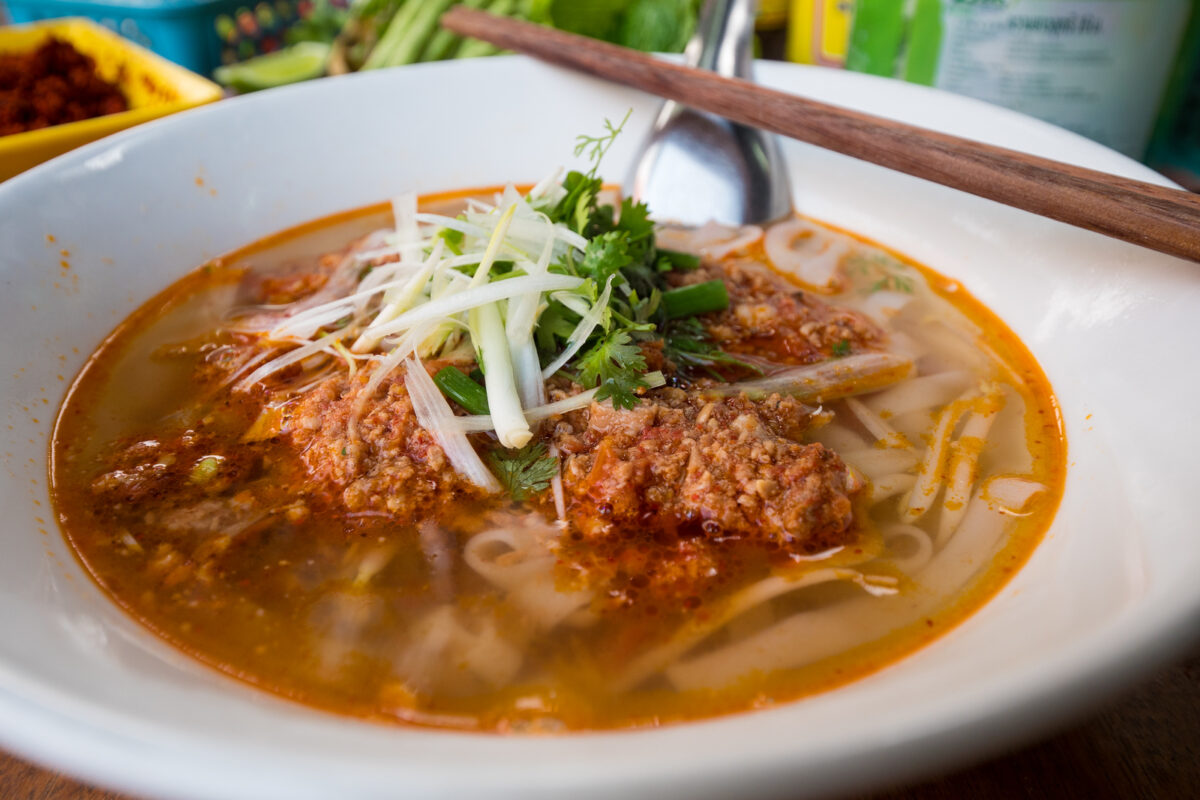
6. Khao Soi
Laos is such a laid-back place that I’m sure the most common argument must be over which restaurant has the best Khao Soi.
You can immediately see how the Laos version differs from the one famous in Thailand in that they make it without using gati (coconut milk). Instead of the creamy, slightly sour Northern Thai version, I noticed right away how cleanly I could taste the meat, a warming pork blend of tomatoey spices.
The minced pork is slow cooked for hours, traditionally over a charcoal fire, the chef turning the meat while mixing in roasted chilis and chili oil as well as herbs that have been crushed using a mortar and pestle.
Customer Satisfaction Guarantee
I tasted galangal, lemongrass, and the small Laos home-grown sour tomatoes as well. This is a dish that will capture both your eye and your appetite – Guaranteed customer satisfaction.
Where to go: The best dish we had was in Luang Prabang, at an unmarked home-restaurant across from the Wat Sene Temple.
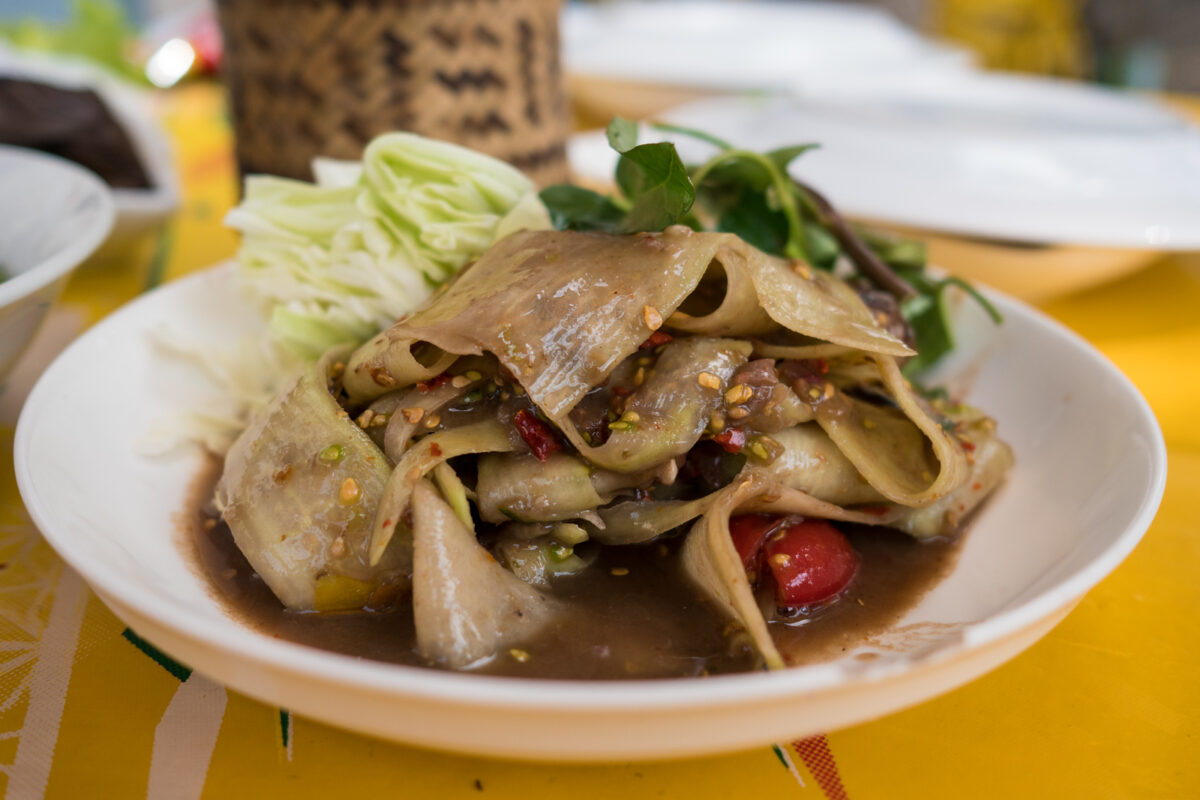
7. Tam
To go a day without eating Tam is almost a challenge in its own right when traveling in Laos. Always paired with sticky rice, this is literally the staple of the Laotian diet.
Made with a variety of fruits, the most common way to have it is with wonderfully crispy shredded green (unripe) papaya, known as tam mak hoong.
Each ingredient is either pounded, sliced, or shredded, but they are all raw, and go one by one into a massive pestle. The pounding of the mortar, the ‘Tam’ action, is what gives this dish its name.
To talk about Tam Mak Hoong as ‘Papaya salad’ though, won’t quite prepare you for what you’ll get when you order a great version. Pa Daek, that dearly loved fermented fish sauce addition in nearly every part of Laos local cuisine, shows its presence nowhere more than in this dish.
Mak Hoong means Papaya, but you can order it with any fruit or vegetable you see around you. Try pointing to something, say the word ‘Tam,’ (sounds like ‘Thumb’) and wait to see if the chef starts to reach for another handful of fresh chilis.
The word ‘Umami’ was invented to describe this next plate
Using what you see around you would be simply following what Laos people have done for centuries – trying out anything that grows as something for fermented fish juices and mashed chilis to grab onto, and thoroughly soak with flavor.
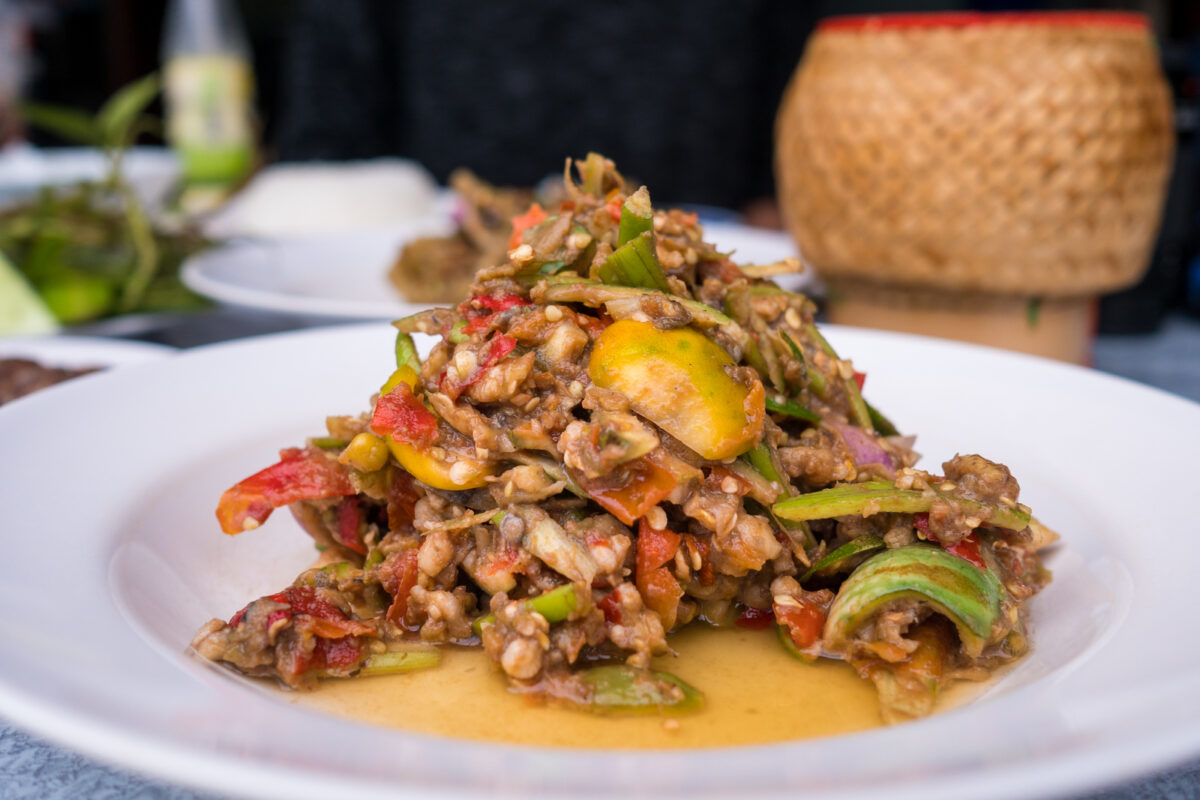
Another impressive version that will blow your taste buds is tam mak kluay, a green banana pounded mixture.
It took me a minute to even begin to put into words the feelings that were coursing through my taste-buds while eating this.
If you can imagine every flavor center of the tongue being pushed to maximum stimulation, that would be the same feeling it will give you. It was insanely sour, while also fully bitter amidst blazing chili heat, while also just umami in the extreme – this dish has it all.
This article gives a great briefing before any Laos food experience. I was even more appreciative after reading it, and I was definitely hungry!
Where to go: Som Tam Luang Prabang in Vientiane
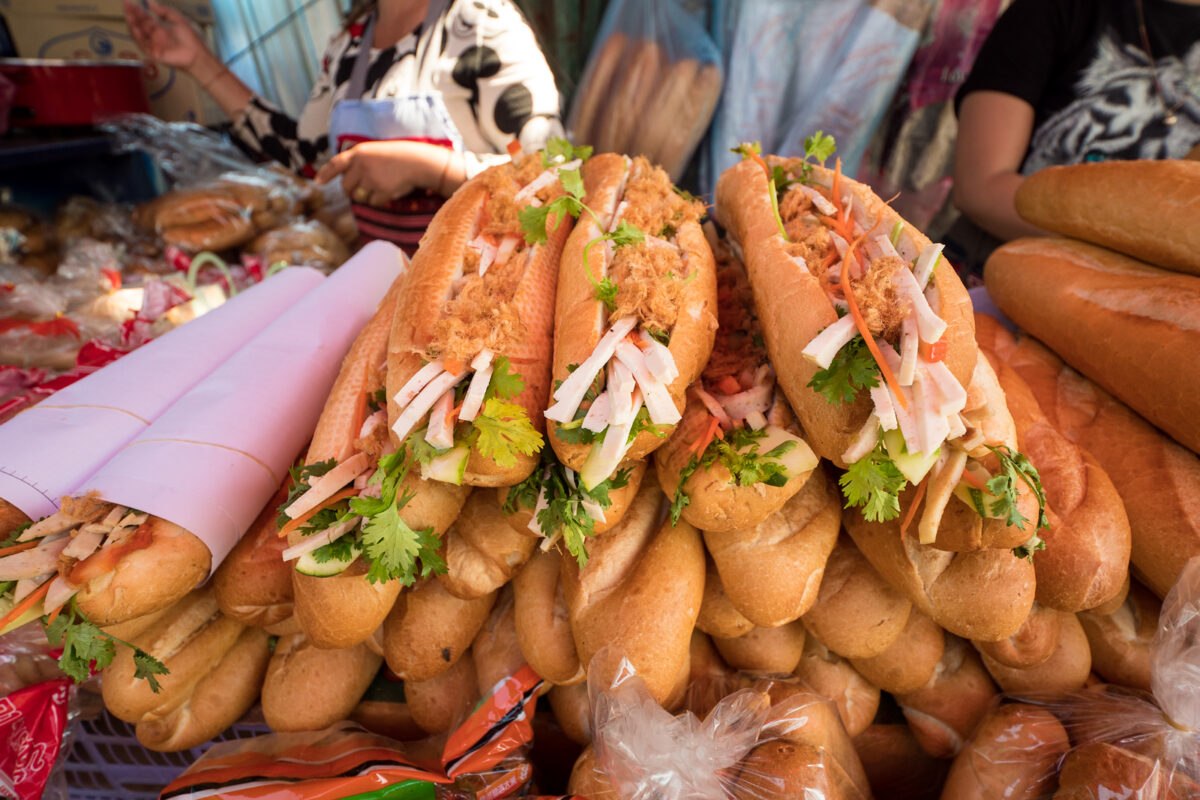
8. Khao Jee Pa-Tay (banh mee)
This sandwich clearly displays Laos’ own food heritage blending with that of its French colonial past.
These massive baguettes are everywhere in Laos, but there’s probably nowhere better to catch the action than the bus station outside the Khua Din morning market in Vientiane. Arguably the quality isn’t the best, but the sheer volume of bread transaction will make your head spin.
Ingredients being scooped, smeared, chopped, then literally thrown into these sandwiches, its almost a competition to see who can create the fastest masterpiece.
Not at all your simple pate-and-bread to eat with wine
The sandwich maker slices the bread lengthwise and then spreads on a thick layer of pate – rich livery flavor, bit also a sticky surface for all the veggies to grab onto. The pate is a must, without it, it just wouldn’t be right.
Next comes the strips of pork sausage, spears of cucumbers, whole green onions, carrots and pickled turnips, and then usually some pork floss. When your eyes are sufficiently bigger than your stomach, the final touch is complete with a few end-to-end layers of sweet and spicy red sauce.
The sandwich is cut in half, and most people walk away eating the first half while carrying the second half to-go. A full-option baguette will range from 10,000-20,000 Kip depending on your order, and to-go (smaller) ones can be as cheap as 5,000 LAK at the bus stop.
Where to go: In Suvannakhet, one of the best sandwiches on earth (opposite from the golden Phonsavanh Bank, its the tallest building in town, and you should order the full option with steak). Also, Khao Gee Mae Sab Restaurant in Vientiane.
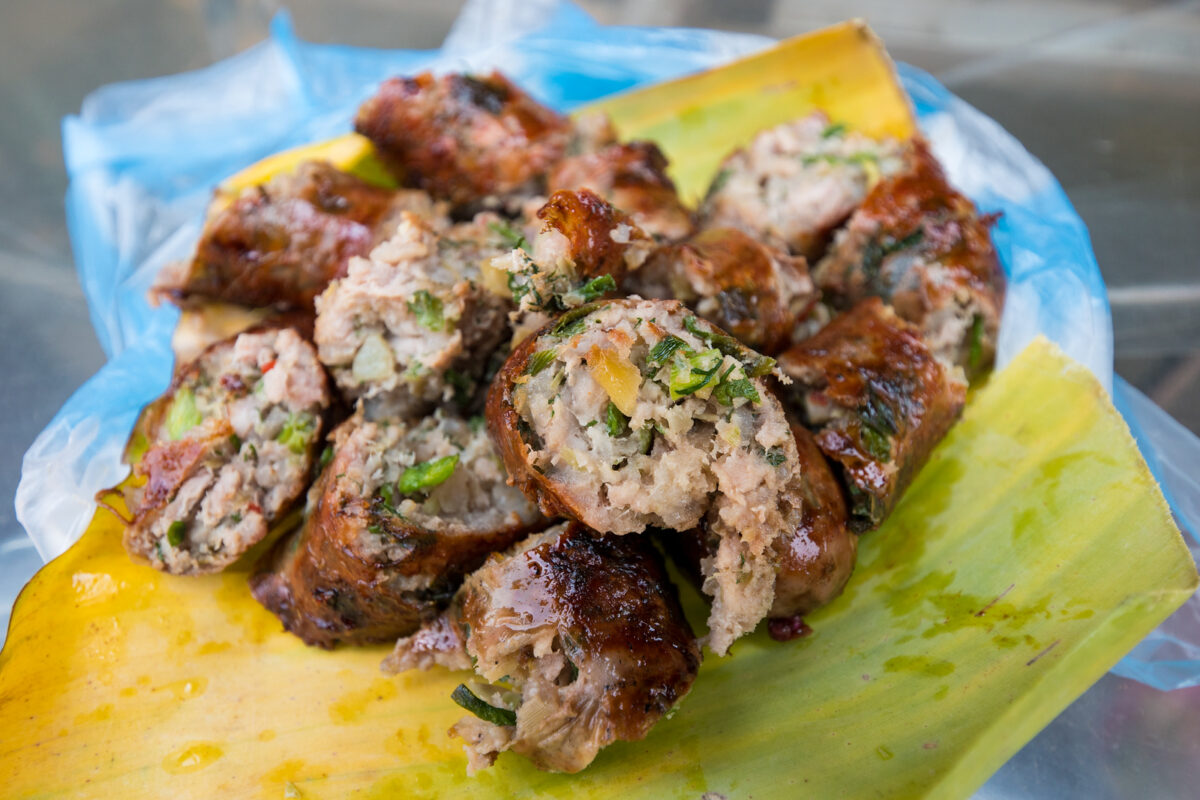
9. Sai Oo-ah
This is one of those Laos foods where you’ll be ordering seconds before you’ve finished your first plate.
Well deserving of a spot on the list of “World’s Best Uses of Meat,” it would be worth your time to visit Laos just to try these.
My mind drifted off as my tongue rejoiced in the fatty goodness and smoky aroma. Sai Oo-ah is the perfect sausage balance of firm, springy, and juicy – the taste available in a single bite is astounding.
Every millimeter of this lovely little sausage is packs absolutely incredible flavor. Using a mixture of pork belly, skin, and minced meat, it can also include diced galangal, chopped green onions, cilantro with a ton of dill, and of course a kick from the fresh chili peppers.
Do yourself a favor, order another one to go
Eat this hot, directly from the grill, and get another two or three in a to-go banana leaf packet.
What truly makes Sai Oo-ah stand out from any other sausage around the world, is the massive herb quantity.
Where to find it: Try it anywhere on the streets of Laos.
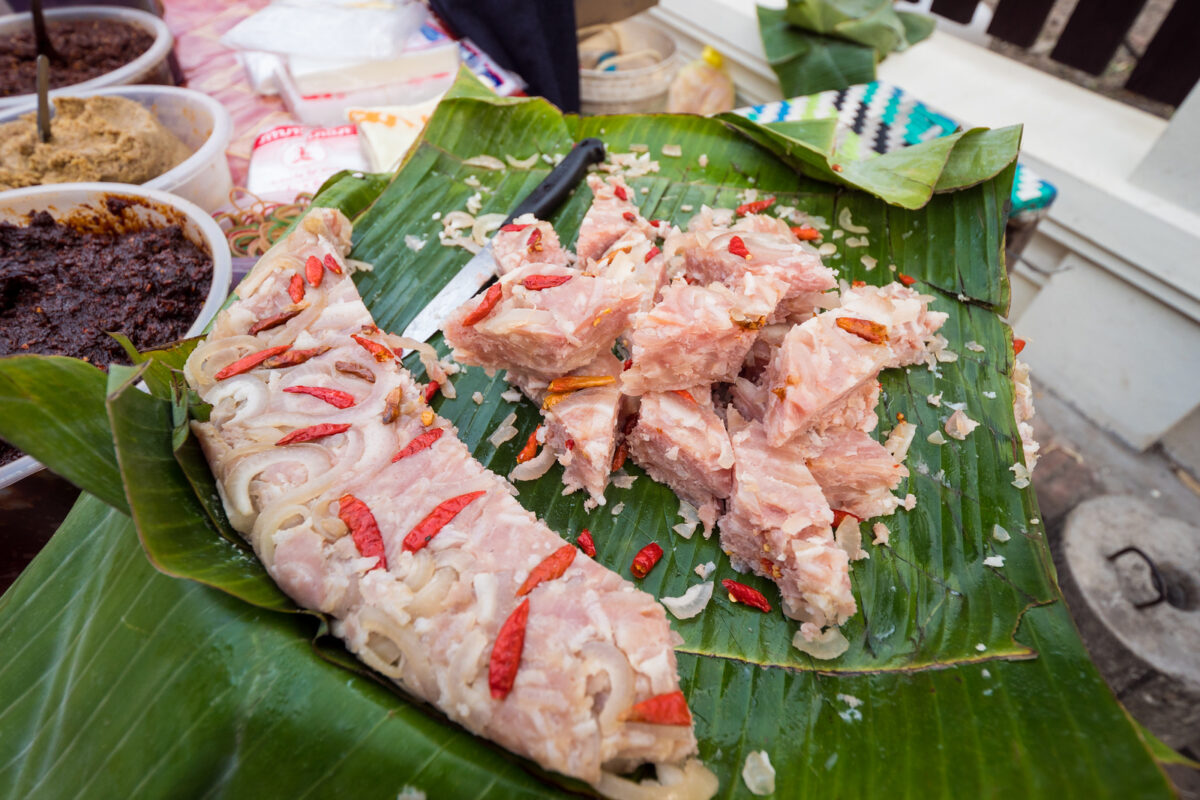
10. Naem
This sun-ripened pork delicacy is a must-find during any morning market stroll when you’re in Laos.
Gently sour flavors and mushy meat goodness, Naem ferments to perfection. This pork mixture cooks with steam before being hung out, usually in bright sunshine for 1-2 days.
Containing various combinations of what might feel at first like all the lesser used parts of the pig (and they most definitely are), this dish is really a beautiful and deliciously efficient way to use more than just the usual cuts of ribs, shoulders, or porkchops.
Using All That Nature Provides
Cartilage crunching, chewy skin goodness, don’t forget the powerfully hot chili peppers, all smoothed together by your necessary dose of collagen, Naem is yet another example of how Laos cuisine is just full of ideas for how to make the best use of all that nature provides.
Where to go: Food night market next to the walking street in Luang Prabang, look for it on a seller’s table. At the morning market in Luang Prabang you’ll find an excellent version.
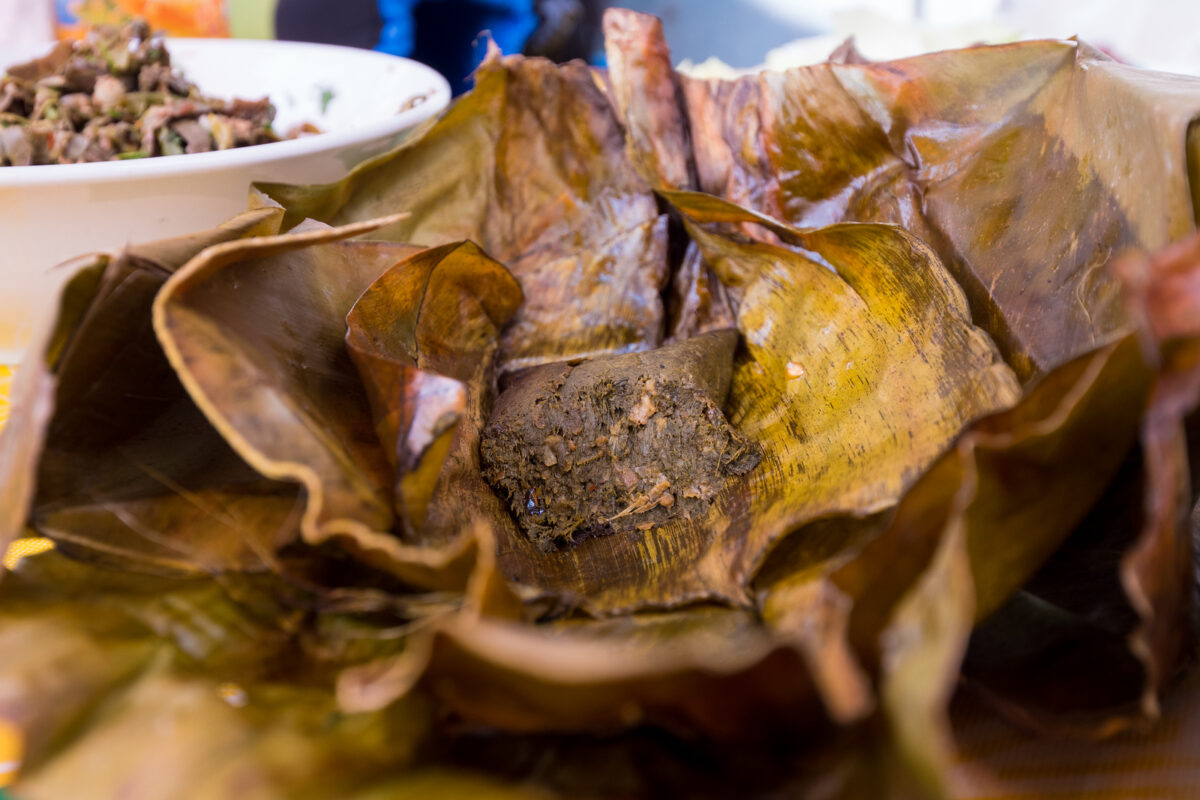
11. Mok
‘Mok’ is the term in Laos for a banana leaf wrap of a near infinite combinations. Typically using either banana or taro leaves, the cooking style is always either steaming, or roasting over coals.
Opening one of these is always exciting when there are so many variations out there to try. Fish, herbs, spices, or even pig brains, are common in a good Mok. And sometimes, if you don’t know all the ingredients, you’ll end up with what I call a “mystery mok.”
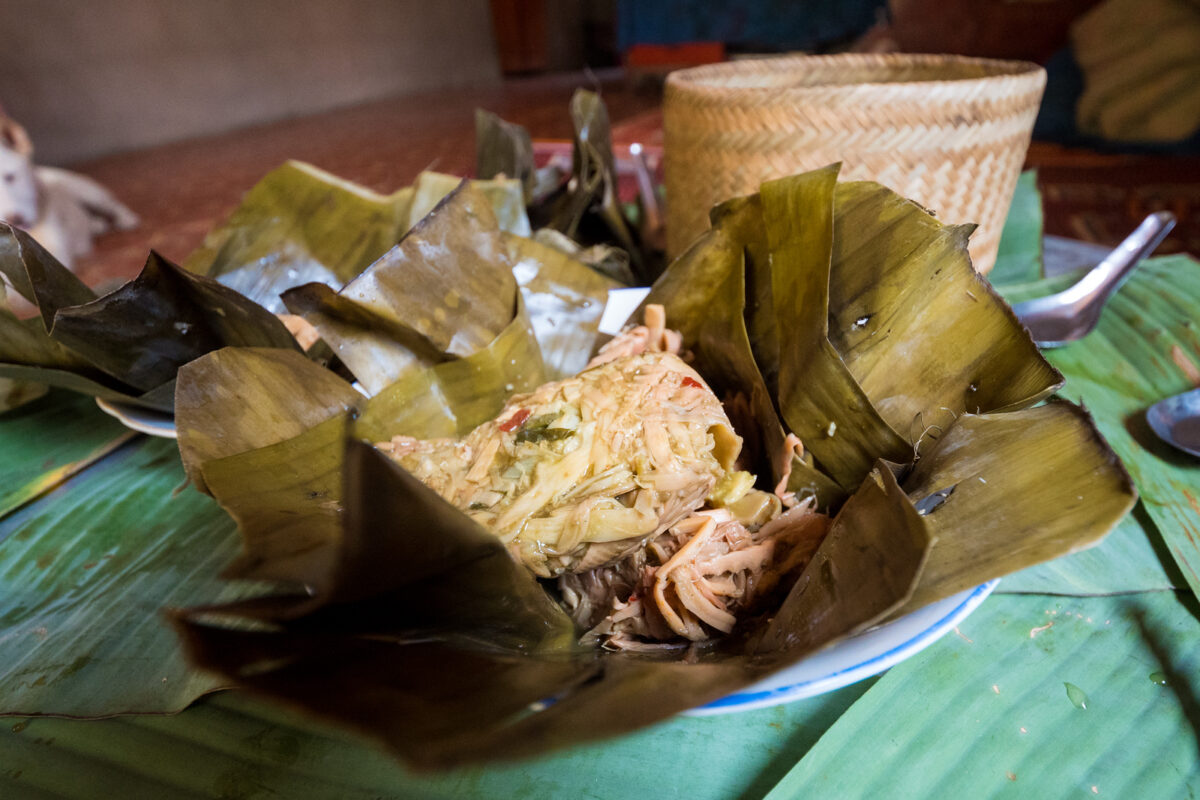
Many look similar on the outside, so you might have to pick a few from the grill until you get the one you actually have in mind. Some chefs use a system of toothpick placement, half-toothpicks or full. I say just buy one of everything and guarantee yourself success.
Lao style mok goes great with sticky rice. I recommend trying the one with pig brains, called Mok Samong, or a gooey and warm bamboo salad, Mok Naw Mai, like the one in the photo below.
There’s no food fun like a good morning Mystery Mok
Where to go: Grills selling this will pop up anywhere, and its also common at markets like the Phou Si fresh market in Luang Prabang.
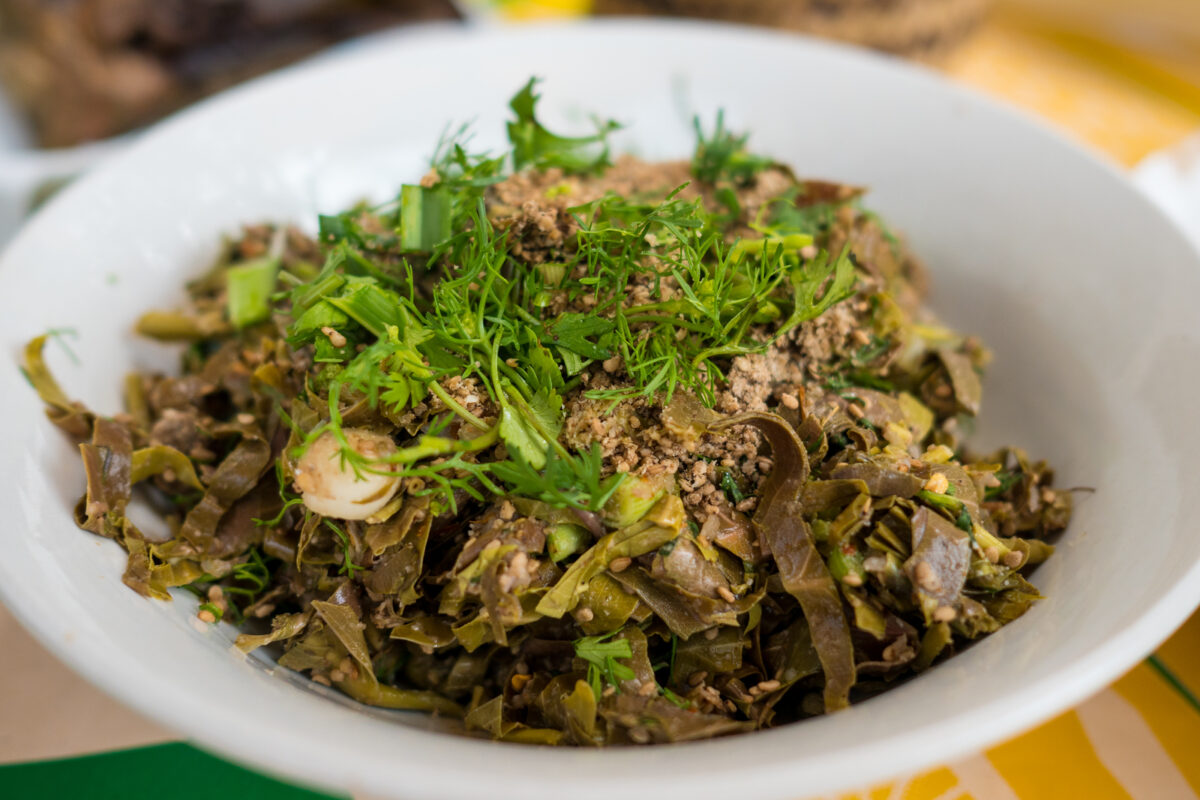
12. Soop Pak
Last but not least, another impressive food on the local menu in Laos is this sour, herb and vegetables filled mix with sesame seeds. You can find many variations of soop pak, some with string beans, others with spinach like greens, and possibly my favorite, a local version with cashew tree leaves.
The vegetables are typically blanched, mixed with herbs, and the most necessary ingredient is a huge amount of sesame seeds to wrap it all together and give it its unique nutty taste.
Not ‘soup,’ but ‘soop!’
Where to go: Soop pak is common at Laotian food stalls selling a variety of different stews and jaew. Ask them for soop pak, and they will surely have some variation of it. Find it at the night market just off the walking street in historical Luang Prabang.
Conclusion
Let me tell you clearly, this is by all means not an exhaustive list of Lao food; This is just the beginning of the amazing world of dishes you can eat in Laos.
What stands out to me, just about more than anything, is the way Laotian food makes extreme use of fresh natural herbs, and when it comes to protein, doesn’t shy away from eating nose to tail – everything from bile to rumen.
Keep enjoying and exploring the glorious cuisine of Laos!
Source: https://migrationology.com/best-laos-food/






















